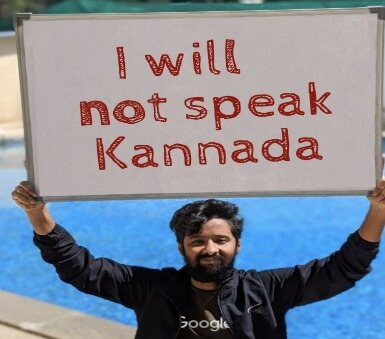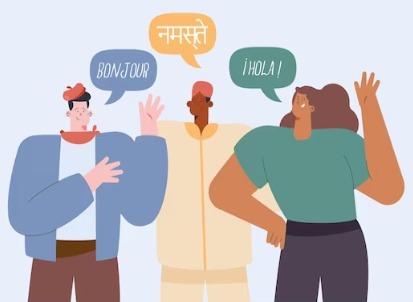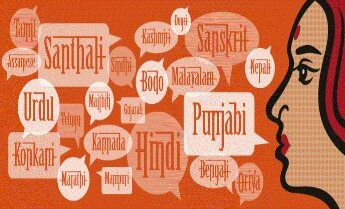Language tension between South Indians and North Indians is a complex issue rooted in historical, cultural, and linguistic differences. While there are many languages spoken across India, Hindi, predominately spoken in North India, often receives official and national prominence, leading to concerns about linguistic hegemony.
South Indians, who speak languages like Tamil, Telugu, Kannada, and Malayalam, among others, often feel marginalized or overlooked in national discourse. Particularly, in Karnataka, the linguistic conflict between the Kannada speakers and non-kannada speakers has always been in the limelight. This linguistic divide can sometimes manifest as tension, especially in political and socio-cultural contexts.
Urbanization and demographic shifts
This linguistic rivalry arises from various factors. One of the primary sources of tension stems from the rapid urbanization and influx of migrants into Karnataka’s cosmopolitan cities. As Bengaluru, the state capital, evolves into a global tech hub, people from various linguistic backgrounds flock to the city in pursuit of opportunities.
This demographic shift has led to concerns among Kannada speakers about the dilution of their language and culture in urban spaces dominated by non-kannada speakers. Urbanisation influences language preferences in education, with parents often choosing schools that offer instructions in language perceived to provide better economic opportunities, potentially impacting the transmission and vitality of Kannada.
Preservation vs. adaptation
At the core of the issue is the struggle to strike a balance between preserving Kannada’s prominence and embracing linguistic diversity. The discussion about preserving the Kannada language and culture in Karnataka versus adapting to linguistic diversity boils down to whether we should protect our heritage or embrace changes influenced by globalization.
Some argue for preserving Kannada to maintain identity, while others think adapting to languages like Hindi and English is necessary for economic success. It’s a debate about balancing tradition and progress in education, business, and daily life while ensuring everyone has fair opportunities regardless of linguistic tension.
Linguistic hegemony and resistance
The concept of linguistic hegemony, where one language holds dominance over others, shapes the perceptions and experiences of both Kannada and non-kannada speakers. For non-Kannada speakers, linguistic hegemony can pose challenges in accessing opportunities such as education, employment, and social integration. It may also contribute to a sense of cultural alienation and a struggle to maintain linguistic and cultural identities in the face of dominant linguistic forces.
On the other hand, Kannada speakers may resist the encroachment of other languages, particularly Hindi and English, viewing them as threats to the integrity of Kannada culture and identity. The dynamics of linguistic hegemony and resistance highlight broader power dynamics in Karanatak, reflecting tensions between linguistic communities and the quest for linguistic equality and recognition.
Incidents of discrimination and marginalization
Instances of discrimination against non-Kannada speakers, highlight the challenges faced by linguistic minorities within the state. Non-kannada speakers may encounter barriers in the job market, including discriminatory hiring practices that favour Kannada speakers or linguistic requirements that prioritise proficiency in Kannada over other languages. This can limit employment opportunities and career advancement, perpetuating economic disparities.

Discrimination in housing may manifest through landlords or housing agencies preferring Kannada-speaking tenants or imposing linguistic restrictions on rental agreements. Non-kannada speakers may face difficulties in finding suitable accommodation, leading to residential segregation and social exclusion.
Inadequate language accessibility to public services can further marginalize non-Kannada speakers, hindering their ability to access essential services such as healthcare, education, and government assistance. Linguistic barriers may result in misunderstandings, limited information access, and unequal treatment, exacerbating social inequalities.
Treatment of North Indians
North Indians in Karnataka may be treated badly for not speaking Kannada due to perceptions of them as outsiders and the expectation for them to assimilate into the local culture. Some Kannada speakers may view North Indians as transient residents who have not fully integrated into the linguistic and cultural fabric of Karnataka. Stereotypes and prejudices play a significant role in shaping interactions between Kannada speakers and non-kannada speakers.
Kannada speakers may feel frustrated by what they perceive as disregard for the Kannada language and culture in North Indians. During the colonial period, British rule in India resulted in the imposition of English as the administrative and educational language. This led to the marginalization of regional languages including Kannada, and the promotion of English as a symbol of modernity and progress.
Citizens have been also involved in various linguistic movements that reflect their deep-seated attachment, which is also visible in contemporary society. For the natives, the Kannada is not merely a means of communication but also a source of pride.
Promoting linguistic harmony
Addressing these challenges requires a multi-faceted approach. Implementing bilingual education programs that emphasize proficiency in both Kannada and another language, can help foster linguistic harmony by promoting multilingualism and respecting diverse linguistic backgrounds. Ensuring language access in public services by providing information and resources in multiple languages can enhance inclusivity and accessibility.

Organizing cultural exchange programs, festivals, and events that celebrate Karnataka’s linguistic and cultural diversity can facilitate interactions among different linguistic communities, promote mutual understanding, and build bridges across linguistic barriers. Promoting diverse linguistic representation in media content, including television, radio, and digital platforms, can reflect the linguistic diversity of Karnataka.
Conclusion
The tension between Kannada and non-Kannada speakers in Karnataka underscores the complexities of navigating linguistic diversity in a rapidly changing society. While the preservation of the Kannada language and culture remains a priority, it is imperative to recognize and celebrate the contributions of all linguistic communities towards the rich tapestry of Karnatak’s heritage.
Embracing linguistic diversity can open doors to new opportunities for collaboration, innovation, and cultural exchange. Only through dialogue, cooperation, and inclusivity can the state pave the way for a harmonious coexistence where every voice is heard and valued.
-TANYA SHAH
MUST READ: ESCALATING TENSIONS OF ECONOMY: A RED SEA CRISIS ONGOING





